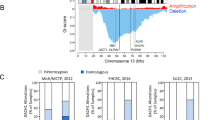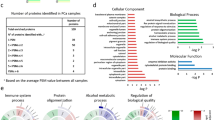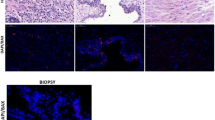Abstract
Early diagnosis of prostate cancer holds tremendous promise for the effective therapy and impact on survival of prostate cancer patients. High-grade prostatic intraepithelial neoplasia (HGPIN) is generally accepted as a lesion indicative of a late pathological event in the premalignant changes leading to full development of prostate cancer. This review seeks to identify specific molecular events that may be linked directly to the molecular transition from benign prostate epithelial cells to prostate carcinoma. HGPIN is pathologically detected in a limited group of men undergoing prostate cancer screening for an elevated serum prostate-specific antigen (PSA) or abnormal digital rectal examination (DRE). Loss of apoptotic control provides a molecular basis for the contribution of specific defective steps in the pathway towards development and progression of prostate cancer. Comparative dissection of the apoptosis status and expression profile of key apoptotic regulators among foci of highly proliferative benign prostatic epithelium, PIN and prostate adenocarcinoma from adjacent areas of the same gland revealed a novel insight into the dysfunctional apoptosis events contributing to prostate carcinogenesis. The sequential and notable loss of the three critical signaling components of the apoptotic action of transforming growth factor-β (TGF-β), in the prostate, that is, the transmembrane receptor II (TβRII), the key cell cycle inhibitor p27Kip1, as well as the protagonist downstream effector of the TGF-β signaling mechanism, Smad4, points to their potential value to ‘faithfully’ characterize HGPIN, as a premalignant prostate lesion. Recent evidence on the molecular changes in apoptosis regulators contributing to HGPIN and their role as molecular markers of disease onset, as well as candidates for therapeutic targeting/chemoprevention of prostate cancer in its early stages will be discussed.
This is a preview of subscription content, access via your institution
Access options
Subscribe to this journal
Receive 4 print issues and online access
$259.00 per year
only $64.75 per issue
Buy this article
- Purchase on Springer Link
- Instant access to full article PDF
Prices may be subject to local taxes which are calculated during checkout



Similar content being viewed by others
References
Weir HK et al. Annual Report to the Nation on the Status of Cancer, 1975–2000, featuring the uses of surveillance data for cancer prevention and control. J Natl Cancer Inst 2003; 95: 1276–1299.
Berges RR et al. Implication of cell kinetic changes during the progression of human prostatic cancer. Clin Cancer Res 1995; 1: 473–480.
Tu H, Jacobs SC, Borkowski A, Kyprianou N . Incidence of apoptosis and cell proliferation in prostate cancer: relationship with TGF-β and bcl-2 expression. Int J Cancer 1996; 69: 357–363.
Foster CS et al. Cellular and molecular pathology of prostate cancer precursors. Scand J Urol Nephrol 2000; 205 (Suppl): 19–43.
Sakr WA, Partin AW . Histological markers of risk and the role of high-grade prostatic intraepithelial neoplasia. Urology 2001; 57: 115–120.
Sakr WA et al. Age and racial distribution of prostatic intraepithelial neoplasia. Eur Urol 1996; 30: 138–144.
Bostwick DG . Prostatic intraepithelial neoplasia is a risk factor for cancer. Semin Urol Oncol 1999; 17: 187–198.
McNeal JE, Bostwick DG . Intraductal dysplasia: a premalignant lesion of the prostate. Hum Pathol 1986; 17: 64–71.
Bostwick DG, Brawer MK . Prostatic intra-epithelial neoplasia and early invasion in prostate cancer. Cancer 1987; 59: 788–794.
Qian J, Wollan P, Bostwick DG . The extent and multicentricity of high grade intraepithial neoplasia in clinically localized prostatic adenocarcinoma. Hum Pathol 1997; 28: 143–148.
Chen JZ et al. Extensive somatic mitochondrial mutations in primary prostate cancer using laser capture microdissection. Cancer Res 2000; 62: 6470–6474.
Zeng L, Rowland RG, Lele SM, Kyprianou N . Apoptotic profiling of premalignant and malignant human prostate. Hum Pathol 2004; 35: 290–297.
Bruckheimer EB, Kyprianou N . Apoptosis in prostate carcinogenesis: a growth regulator and a therapeutic target. Cell Tissue Res 2000; 301: 152–162.
Malkin D et al. Germ line p53 mutations in a familial syndrome of breast cancer sarcomas and other neoplasms. Science 1990; 250: 1233–1238.
Hollstein M, Sidransky D, Vogelstein B, Harris CC . p53 mutations in human cancers. Science 1991; 253: 492–495.
Bauer JJ et al. p53 nuclear protein expression is an independent prognostic marker in clinically localized prostate cancer patients undergoing radical prostatectomy. Clin Cancer Res 1995; 1: 1295–1300.
Krupsky T, Petroni GR, Frienson HG, Theodorescu D . Microvessel density, p53, retinoblastoma, and chromogranin A immunohistochemistry as predictors of disease-specific survival following radical prostatectomy for carcinoma of the prostate. Urology 2000; 55: 743–749.
Borner MM et al. Drug-induced apoptosis is not necessarily dependent on macromolecular synthesis of proliferation in the p53-negative human prostate cell line PC3. Cancer Res 1995; 55: 2122–2128.
Kuczyk MA et al. The prognostic value of p53 for long-term and recurrence-free survival following radical prostatectomy. Eur J Cancer 1998; 34: 679–686.
Stapleton AMF et al. Assessment of the biological markers p53, Ki-67, and apoptotic index as predictive indicators of prostate carcinoma recurrence after surgery. Cancer 1998; 82: 168–175.
Myers RB, Oelschlager D, Srivastava S . Accumulation of the p53 protein occurs more frequently in metastatic than in localized prostatic adenocarcinomas. Prostate 1998; 25: 243–248.
Tamboli P, Amin MB, Xu HJ . Immunohistochemical expression of retinoblastoma and p53 tumor suppressor genes in prostatic intraepithelial neoplasia: comparison with prostate adenocarcinoma and benign prostate. Mod Pathol 1998; 11: 247–252.
Bottner M, Krieglstein K, Unsicker K . The transforming growth factor-betas: structure, signaling, and roles in nervous system development and functions. J Neurochem 2000; 75: 2227–2240.
Dünker N, Schuster N, Krieglstein K . Transforming growth factor beta modulates programmed cell death in the retina of the developing chick embryo. Development 2001; 128: 1933–1942.
Roberts AB, Wakefield LM . The two faces of transforming growth factor in carcinogenesis. Proc Natl Acad Sci USA 2003; 100: 8621–8623.
Guo Y, Kyprianou N . Restoration of transforming growth factor beta signaling pathway in human prostate cancer suppresses tumorigenicity via induction of caspase-1-mediated apoptosis. Cancer Res 1999; 15: 1366–1371.
Cardillo MR, Petrangeli E, Perracchio L . Transforming growth factor-β expression in prostate neoplasia. Anal Quant Cytol Histol 2000; 22: 1–10.
Massague J, Wotton D . Transcriptional control by the TGF-β/Smad signaling system. EMBO J 2000; 19: 1745–1754.
Larisch S et al. A novel mitochondrial septin-like protein, ARTS, mediates apoptosis dependent on its P-loop motif. Nat Cell Biol 2000; 2: 915–921.
Kim I et al. Loss of expression of transforming growth factor-β receptors is associated with poor prognosis in prostate cancer patients. Clin Cancer Res 1998; 4: 1625–1630.
Gold L . The role of transforming growth factor-β (TGF-β) in human cancer. Crit Rev Oncog 1999; 10: 303–360.
Taketo MM, Takatu K . Gastro-intestinal tumorigenesis in Smad4 mutant mice. Cytokine Growth Factor Rev 2000; 11: 147–157.
Brodin G et al. Increased Smad expression and activation are associated with apoptosis in normal and malignant prostate after castration. Cancer Res 1999; 59: 2731–2738.
Coats S et al. A new pathway for mitogen-dependent Cdk2 regulation uncovered in p27Kip1-deficient cells. Curr Biol 1999; 9: 163–173.
Lloyd R et al. p27Kip1: A multifunctional cyclin-dependent kinase inhibitor with prognostic significance in human cancers. Am J Pathol 1999; 154: 313–323.
Chen J, Willingham T, Shuford M, Nisen PD . Tumor suppression and inhibition of aneuploid cell accumulation in human brain tumor cells by ectopic overexpression of the cyclin-dependent kinase inhibitor p27Kip1. J Clin Invesrt 1996; 97: 1983–1988.
Guo YP et al. Loss of the cyclin-dependent kinase inhibitor p27Kip1 protein in human prostate cancer correlates with tumor grade. Clin Cancer Res 1997; 3: 2269–2274.
Catzavelos C et al. Decreased levels of the cell-cycle inhibitor p27Kip1 protein: prognostic implications in primary breast cancer. Nat Med 1997; 3: 227–230.
Esposito V et al. Prognostic role of the cyclin-dependent kinase inhibitor p27 in non-small cell lung cancer. Cancer Res 1997; 57: 3381–3385.
Loda M et al. Increased proteasome-dependent degradation of the cyclin-dependent kinase inhibitor p27 in aggressive colorectal carcinomas. Nat Med 1997; 3: 231–234.
Sgambato A et al. Loss of p27Kip1expression correlates with tumor grade and with reduced disease-free survival in primary superficial bladder cancers. Cancer Res 1999; 59: 3245–3250.
Tsihlias J et al. Loss of cyclin-dependent kinase inhibitor p27Kip1 is a novel prognostic factor in localized human prostate adenocarcinoma. Cancer Res 1998; 58: 542–548.
Cote RJ et al. Association of p27Kip1 levels with recurrence and survival in patients with stage C prostate carcinoma. J Natl Cancer Inst 1998; 90: 916–920.
De Marzo et al. Prostate stem cell compartments: expression of the cell cycle inhibitor p27Kip1 in normal hyperplastic and neoplastic cells. Am J Pathol 1998; 153: 911–919.
Carrano AC et al. SKP2 is required for ubiquitin-mediated degradation of the CDK inhibitor p27. Nat Cell Biol 1999; 1: 193–199.
Sutterluty H et al. p45SKP2 promotes p27Kip1 degradation and induces S phase in quiescent cells. Nat Cell Biol 1999; 1: 207–214.
Mamillapalli R et al. PTEN regulates the ubiquitin-dependent degradation of the CDK inhibitor p27(KIP1) through the ubiquitin E3 ligase SCF9(SKP2). Curr Biol 2001; 11: 263–367.
Hershko D et al. Inverse relation between levels of p27Kip1 and of its ubiquitin ligase subunit Skp2 in colorectal carcinomas. Cancer 2001; 91: 1745–1751.
Yang G et al. Elevated Skp2 protein expression in human prostate cancer: association with loss of the cyclin-dependent kinase inhibitor p27 and PTEN and with reduced recurrence-free survival. Clin Cancer Res 2002; 8: 3419–3426.
Sakr WA et al. Epidemiology of high-grade prostatic intraepithelial neoplasia. Scand J Urol Nephrol 2000; 205 (Suppl): 11–18.
Sakr WA, Haas GP, Cassin BJ . Frequency of prostatic intraepithelial neoplasia and invasive carcinoma in young males. J Urol 1993; 150: 379–385.
Greenberg N et al. Prostate cancer in a transgenic mouse. Proc Natl Acad Sci USA 1995; 92: 3439–3443.
Kasper S et al. Development, progression, and androgen-dependence of prostate tumors in probasin-large T antigen transgenic mice: a model for prostate cancer. Lab Invest 1998; 78: 1–15.
Stanbrough M et al. Prostatic intraepithelial neoplasia in mice expressing an androgen receptor transgene in prostate epithelium. Proc Natl Acad Sci USA 2001; 98: 10823–10828.
DiGiovanni J et al. Deregulated expression of insulin-like growth factor 1 in prostate epithelium leads to neoplasia in transgenic mice. Proc Natl Acad Sci USA 2000; 97: 3455–3460.
Masumori N et al. A probasin-large T antigen transgenic mouse line develops prostate adenocarcinoma and neuroendocrine carcinoma with metastatic potential. Cancer Res 2001; 61: 2239–2249.
Henshall SM et al. Overexpression of the cell cycle inhibitor p16INK4A in high-grade prostatic intraepithelial neoplasia predicts early relapse in prostate cancer patients. Clin Cancer 2001; 7: 544–550.
Song ZG et al. Fibroblast growth factor 8 isoform b overexpression in prostate epithelium: a new mouse model for prostatic intraepithelial neoplasial. Cancer Res 2002; 62: 5096–5105.
Gary KL et al. Follow up interval prostate biopsy 3 years after diagnosis of high grade prostatic intraepithelial neoplasia is associated with high likelihood of prostate cancer, independent of change in prostate specific antigen levels. J Urol 2002; 168: 1415–1418.
Park S, Shinohara K, Grossfeld GD, Carroll P . Prostate cancer detection in men with prior high grade prostate intraepithelial neoplasia or atypical prostate biopsy. J Urol 2001; 165: 1409–1414.
Langer JE, Rovner ES, Coleman BG . Strategy for repeat biopsy of patients with prostatic intraepithelial neoplasia detected by prostate needle biopsy. J Urol 1996; 155: 228–232.
Raghow S, Hooshdaran MZ, Katiyar S, Steiner MS . Toremifene prevents prostate cancer in the transgenic adenocarcinoma of mouse prostate model. Cancer Res 2002; 62: 1370–1376.
Cunha GR, Wang YZ, Hayward SW, Risbridger GP . Estrogenic effects on prostatic differentiation and carcinogenesis. Reprod Fertil Dev 2001; 13: 285–296.
Sugiura T et al. Combination chemotherapy with JTE-522, a novel selective cyclooxygenase-2 inhibitor, and cisplatin against gastric cancer cell lines in vitro and in vivo. In vivo 2003; 17: 229–233.
Gataly S, Kerbel R . Therapeutic potential of selective cyclooxygenase-2 inhibitors in the management of tumor angiogenesis. Prog Exp Tumor Res 2003; 37: 179–183.
Yoshida K et al. A COX-2 inhibitor, nimesulide, inhibits chemically-induced rat tongue carcinogenesis through suppression of cell proliferation activity and COX-2 and iNOS expression. Histol Histopathol 2003; 18: 39–48.
Rao CV et al. Chemopreventive properties of a selective inducible nitric oxide synthetase inhibitor in colon carcinogenesis, administered alone or in combination with celecoxib, a selective cyclooxygenase-2 inhibitor. Cancer Res 2002; 62: 165–170.
Guise TA, Yin JJ, Mohammad KS . Role of endothelin-1 in osteoblastic bone metastases. Cancer 2003; 97: 779–784.
Kopetz ES, Nelson JB, Carducci MA . Endothelin-1 as a target for therapeutic intervention in prostate cancer. Invest New Drugs 2002; 20: 173–182.
Krzystyniak KL . Current strategies for anticancer chemoprevention and chemoprotection. Acta Pol Pharm 2002; 59: 473–478.
Pollak M, Beamer W, Zhang JC . Insulin-like growth factors and prostate cancer. Cancer Metast Rev 1999; 17: 283–287.
Brawley OW . Hormonal prevention of prostate cancer. Urol Oncol 2003; 21: 67–72.
Satoh T et al. Adenoviral vector-mediated mRTVP-1 gene therapy for prostate cancer. Hum Gene Ther 2003; 14: 91–101.
Nicholson B, Theodorescu D . Molecular therapeutics in prostate cancer. Histol Histopathol 2003; 18: 275–298.
Pantuck AJ et al. New biologicals for prostate cancer prevention: genes, vaccines, and immune-based interventions. Urology 2001; 57 (suppl): 95–99.
Wheeler TM . Influence of irradiation and androgen ablation on prostatic intraepithelial neoplasia. Eur Urol 1996; 30: 261–264.
Trump DL et al. Androgen antagonists: potential role in prostate cancer prevention. Urol 2001; 57 (Suppl): 64–67.
Tolcher AW et al. Other novel agents: rationale and current status as chemopreventive agents. Urol 2001; 57 (Suppl): 86–89.
Steiner MS, Raghow S, Neubauer BL . Selective estrogen receptor modulators for the chemoprevention of prostate cancer. Urol 2001; 57 (Suppl 1): 68–72.
Alberts S, Blute M . Chemoprevention for prostatic carcinoma: the role of flutamide in patients with prostatic intraepithelial neoplasia. Urol 2001; 57 (Suppl 1): 188–190.
Blaji KC, Rabbani F, Tsai H . Effect of neoadjuvant hormonal therapy on prostatic intraepithelial neoplasia and its prognostic significance. J Urol 1999; 162: 753–757.
Montironi R, Santinelli A, Mazzucchelli R . Prostatic intraepithelial neoplasia and prostate cancer. Panminerva Med 2002; 44: 213–220.
van der Kwast TH, Labrie F, Tetu B . Persistence of high-grade prostatic intra-epithelial neoplasia under combined androgen blockade therapy. Hum Pathol 1999; 30: 1503–1507.
Vaillancourt L et al. Effect of neoadjuvant endocrine therapy (combined androgen blockade) on normal prostate and prostatic carcinoma: A randomized study. Am J Surg Pathol 1996; 20: 86–93.
Acknowledgements
These studies were supported by an NIH R01 Grant (DK-53525-05). We thank Dr Randall Rowland, Chief, Division of Urology, University of Kentucky Medical Center, for enabling the availability of human prostate tissue specimens.
Author information
Authors and Affiliations
Corresponding author
Rights and permissions
About this article
Cite this article
Zeng, L., Kyprianou, N. Apoptotic regulators in prostatic intraepithelial neoplasia (PIN): value in prostate cancer detection and prevention. Prostate Cancer Prostatic Dis 8, 7–13 (2005). https://doi.org/10.1038/sj.pcan.4500757
Received:
Revised:
Accepted:
Published:
Issue Date:
DOI: https://doi.org/10.1038/sj.pcan.4500757
Keywords
This article is cited by
-
XAF1 expression and regulatory effects of somatostatin on XAF1 in prostate cancer cells
Journal of Experimental & Clinical Cancer Research (2010)
-
Androgen-induced programs for prostate epithelial growth and invasion arise in embryogenesis and are reactivated in cancer
Oncogene (2008)
-
Alteration of proliferation and apoptotic markers in normal and premalignant tissue associated with prostate cancer
BMC Cancer (2006)



